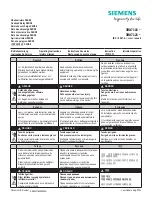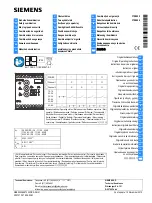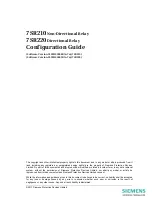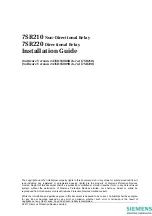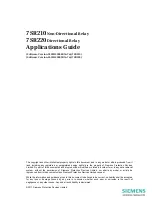
I.L. 40-385.1B
3-4
(5/92)
reclosed on an end-zone permanent fault, the nor-
mal Z2T will take place.
For a remote external fault, either Z1P or Z1G will
see the fault since they are set to overreach. High
speed trip will be performed. HST signal operates
the instantaneous reclosing scheme. The breaker
recloses and stays closed if the fault has been isolat-
ed by the adjacent line breaker. However, if the
adjacent line breaker fails to trip, the normal remote
back up will take place.
NOTE: The reaches of Z1E are based on the
Zone 1 settings multiplied by a factor of
1.25 (e.g., 1.25 x Z1P and 1.25 x Z1G).
3.4
MDAR NON-PILOT FEATURES
The following features are standard with the
Non-Pilot MDAR
3.4.1
3-Zone Distance Phase and Ground Relay
with Reversible Zone 3 Phase and Ground
There are four impedance units per zone: one
phase-to-phase unit and three phase-to-ground
units. Zone 3 can be set to forward or reverse for car-
rier keying or back-up tripping in pilot system appli-
cations.
3.4.2
Directional or Non-Directional Inverse
Time Overcurrent Ground Backup Logic
The overcurrent ground backup (GB) unit is to sup-
plement the distance ground protection on high re-
sistance ground faults. It provides an inverse time
characteristic which is similar to the conventional CO
characteristics (see Figure 2-1 thru 2-7). The time
curves can be selected by the GBCV Setting. The
time dial is set by the “GTC” value. The unit can be
selected as directional by using the “GDIR” (YES)
setting and the pickup value by GBPU. The direc-
tional GB function uses the torque control approach,
as indicated in Figure 3-9. The GB function can be
disabled by setting the GBCV to the OUT position.
The directional unit is determined by the setting of
“DIRU” which can be set to zero sequence voltage
(ZSEQ), dual (DUAL, zero sequence voltage and/or
zero sequence current) or negative sequence
(NSEQ, negative sequence voltage and negative se-
quence current) for polarization (see 3.4.11, Select-
able Ground Directional Unit, ZSEQ / NSEQ /
DUAL).
3.4.3
Loss of Potential Supervision (LOP)
The ac voltage monitoring circuit is called loss-of-po-
tential circuit. In order to prevent undesirable tripping
due to the distance unit(s) pickup on loss-of-poten-
tial, the following logic is used:
• (V
AN
or V
BN
or V
CN
<7Vac) or (3Vo>7Vac) and
not
∆
I or not (3I
O
>I
OS
)
This means that the LOPB will be set if any one of
the voltages is below 7Vac (without
∆
I), or if the sys-
tem detects 3Vo without 3Io (or 3I
O
> I
OS
) as shown
in Figure 3-10. The (loss-of-potential condition satis-
fies AND-1; output signal of AND-1 starts the 8/500
ms timer. The timer output will satisfy AND-1C if
there is no output from AND-1B. Output signal of
AND-1C will block all the distance unit (Z) tripping
paths via AND-2, AND-3, AND-4, AND-5, AND-6,
AND-172 (also blocks AND-191 and AND-187 for Pi-
lot Systems), if LOPB is set at YES. Although all dis-
tance units are blocked for tripping, the ground
backup (GB) and high-set overcurrent units (ITP and
ITG) are operative and converted to non-directional
automatically. The LOPB blocking function can be
disabled by setting the LOPB functional display at
NO position. The output of the LOP timer will de-en-
ergize the alarm 1 (AL1) relay and cause the failure
alarm.
When applying the LOPB to YES, it is the intent to
block all distance units from tripping, should LOP
condition exist. However, under a special system
condition (refer to Figure 3-11), both circuits are en-
ergized without load current; with no source at termi-
nal B, fault at F where F is near terminal A, Zone 2
relay at terminal B will be blocked by LOP, and may
fail to trip. This is because the relay at B sees no cur-
rent, and a low voltage condition exists before circuit
breaker A opens. Another special system condition
involves two parallel lines with two symmetrical
sources at both ends. For an evolving flashover
fault, at a point equidistant from both terminals, the
conventional LOPB logic will block trip, because the
first external fault generates “3V0 and not 3I
0
“on the
protected line. Logic AND-1A, 1B, -1C, and -1E 150/
0, 0/3500 ms timers circuit (in Figure 3-10) are for
solving these problems. This logic unblocks the
LOPB circuit and provides a 3500 ms trip window for
the distance units to trip if the fault current is detect-
Содержание REL-300
Страница 30: ......
Страница 32: ......
Страница 33: ......
Страница 38: ......
Страница 39: ......
Страница 40: ......
Страница 41: ......
Страница 42: ......
Страница 43: ......
Страница 44: ......
Страница 45: ......
Страница 62: ......
Страница 63: ......
Страница 64: ......
Страница 65: ......
Страница 66: ......
Страница 67: ......
Страница 68: ......
Страница 69: ......
Страница 70: ......
Страница 71: ......
Страница 72: ......
Страница 73: ......
Страница 74: ......
Страница 75: ......
Страница 76: ......
Страница 77: ......
Страница 86: ......
Страница 87: ......
Страница 88: ......
Страница 116: ...I L 40 385 1B 6 14 5 92 Figure 6 1 Test Connection for Single Phase to Ground Faults Sheet 1 of 4...
Страница 117: ...I L 40 385 1B 5 92 6 15 Figure 6 2 Test Connection for Three Phase Faults 1502B51 Sub 1 Sheet 2 of 4...
Страница 118: ...I L 40 385 1B 6 16 5 92 Figure 6 3 Test Connection for Phase to Phase Faults 1502B51 Sub 1 Sheet 3 of 4...
Страница 131: ......
Страница 132: ......
Страница 133: ......
Страница 134: ......
Страница 135: ...I L 40 385 1B SD 6 5 92 Figure SD 2 MDAR Block Diagram sheet 1 of 1 Sub 1 1611C12...

































